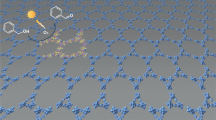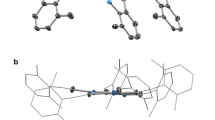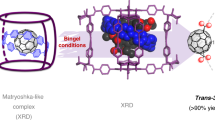Abstract
Two-dimensional (2D) structures have been shown to possess interesting and potentially useful properties. Because of their isotropic structure, however, clusters tend to assemble into 3D architectures. Here we report the assembly of polyoxometalate clusters into layered structures that feature uniform hexagonal pores and in-plane electron delocalization properties. Because these structures are 2D and visually reminiscent of graphene, they are referred to as ‘clusterphenes’. A series of multilayer and monolayer clusterphenes have been constructed with 13 types of polyoxometalate cluster. The resulting clusterphenes were shown to exhibit substantially improved stability and catalytic efficiency towards olefin epoxidation reactions, with a turnover frequency of 4.16 h−1, which is 76.5 times that of the unassembled clusters. The catalytic activity of the clusterphenes derives from the electron delocalization between identical clusters within the 2D layer, which efficiently reduces the activation energy of the catalytic reaction.

This is a preview of subscription content, access via your institution
Access options
Access Nature and 54 other Nature Portfolio journals
Get Nature+, our best-value online-access subscription
$29.99 / 30 days
cancel any time
Subscribe to this journal
Receive 12 print issues and online access
$259.00 per year
only $21.58 per issue
Buy this article
- Purchase on Springer Link
- Instant access to full article PDF
Prices may be subject to local taxes which are calculated during checkout






Similar content being viewed by others
Data availability
All the data supporting the findings of this study are available within the article and its Supplementary Information and also from the corresponding authors upon reasonable request.
References
Ma, H. & Hao, J. Ordered patterns and structures via interfacial self-assembly: superlattices, honeycomb structures and coffee rings. Chem. Soc. Rev. 40, 5457–5471 (2011).
Novoselov, K. S. et al. Electric field effect in atomically thin carbon films. Science 306, 666–669 (2004).
Malard, L. M., Pimenta, M. A., Dresselhaus, G. & Dresselhaus, M. S. Raman spectroscopy in graphene. Phys. Rep. 473, 51–87 (2009).
Grigorenko, A. N., Polini, M. & Novoselov, K. S. Graphene plasmonics. Nat. Photon. 6, 749–758 (2012).
Rao, C. N., Sood, A. K., Subrahmanyam, K. S. & Govindaraj, A. Graphene: the new two-dimensional nanomaterial. Angew. Chem. Int. Ed. 48, 7752–7777 (2009).
Dong, A., Chen, J., Vora, P. M., Kikkawa, J. M. & Murray, C. B. Binary nanocrystal superlattice membranes self-assembled at the liquid–air interface. Nature 466, 474–477 (2010).
Redl, F. X., Cho, K. S., Murray, C. B. & O’Brien, S. Three-dimensional binary superlattices of magnetic nanocrystals and semiconductor quantum dots. Nature 423, 968–971 (2003).
Hou, X. S. et al. Mesoscale graphene-like honeycomb mono- and multilayers constructed via self-assembly of coclusters. J. Am. Chem. Soc. 140, 1805–1811 (2018).
Murray, C. B., Kagan, C. R. & Bawendi, M. G. Synthesis and characterization of monodisperse nanocrystals and close-packed nanocrystal assemblies. Annu. Rev. Mater. Sci. 30, 545–610 (2000).
Busche, C. et al. Design and fabrication of memory devices based on nanoscale polyoxometalate clusters. Nature 515, 545–549 (2014).
Rhule, J. T., Hill, C. L., Judd, D. A. & Schinazi, R. F. Polyoxometalates in medicine. Chem. Rev. 98, 327–358 (1998).
Hill, C. L. Progress and challenges in polyoxometalate-based catalysis and catalytic materials chemistry. J. Mol. Catal. A 262, 2–6 (2007).
Howells, A. R., Sankarraj, A. & Shannon, C. A diruthenium-substituted polyoxometalate as an electrocatalyst for oxygen generation. J. Am. Chem. Soc. 126, 12258–12259 (2004).
Walsh, J. J., Bond, A. M., Forster, R. J. & Keyes, T. E. Hybrid polyoxometalate materials for photo(electro-) chemical applications. Coord. Chem. Rev. 306, 217–234 (2016).
Long, D. L., Burkholder, E. & Cronin, L. Polyoxometalate clusters, nanostructures and materials: from self assembly to designer materials and devices. Chem. Soc. Rev. 36, 105–121 (2007).
Song, Y. F. & Tsunashima, R. Recent advances on polyoxometalate-based molecular and composite materials. Chem. Soc. Rev. 41, 7384–7402 (2012).
Liu, Q. et al. Single molecule-mediated assembly of polyoxometalate single-cluster rings and their three-dimensional superstructures. Sci. Adv. 5, eaax1081 (2019).
Liu, J. et al. Incorporation of clusters within inorganic materials through their addition during nucleation steps. Nat. Chem. 11, 839–845 (2019).
Khanna, S. N. & Jena, P. Atomic clusters: building blocks for a class of solids. Phys. Rev. B 51, 13705–13716 (1995).
Liu, L., Li, P., Yuan, L. F., Cheng, L. & Yang, J. From isosuperatoms to isosupermolecules: new concepts in cluster science. Nanoscale 8, 12787–12792 (2016).
Luo, Z. & Castleman, A. W. Special and general superatoms. Acc. Chem. Res. 47, 2931–2940 (2014).
Reber, A. C. & Khanna, S. N. Superatoms: electronic and geometric effects on reactivity. Acc. Chem. Res. 50, 255–263 (2017).
Niu, J. et al. Assembly chemistry between lanthanide cations and monovacant Keggin polyoxotungstates: two types of lanthanide substituted phosphotungstates [{(α-PW11O39H)Ln(H2O)3}2]6− and [{(α-PW11O39)Ln(H2O)(η2,μ−1,1)-CH3COO}2]10−. Cryst. Growth Des. 9, 4362–4372 (2009).
Ji, Y., Huang, L., Hu, J., Streb, C. & Song, Y.-F. Polyoxometalate-functionalized nanocarbon materials for energy conversion, energy storage and sensor systems. Energy Environ. Sci. 8, 776–789 (2015).
Wang, S. S. & Yang, G. Y. Recent advances in polyoxometalate-catalyzed reactions. Chem. Rev. 115, 4893–4962 (2015).
Duncan, D. C., Chambers, R. C., Hecht, E. & Hill, C. L. Mechanism and dynamics in the H3[PW12O40]-catalyzed selective epoxidation of terminal olefins by H2O2. formation, reactivity and stability of {PO4[WO(O2)2]4}3−. J. Am. Chem. Soc. 117, 681–691 (1995).
Acknowledgements
This work was supported by the National Key R&D Program of China (2017YFA0700101), NSFC (22035004), the XPLORER PRIZE, the China National Postdoctoral Program for Innovative Talents (BX2021145) and Shuimu Tsinghua Scholar Program. We thank X. Xu for his help with density functional theory calculations.
Author information
Authors and Affiliations
Contributions
X.W. proposed and guided the project. Q.L. designed, planned and carried out the experiments and analysed data. Q.Z. performed the TEM imaging and analysis. W.S. performed the MD simulations. H.H. performed the density functional theory calculations. J.Z. performed the gas chromatography mass spectrometry tests. All authors discussed the results and commented on the manuscript.
Corresponding author
Ethics declarations
Competing interests
The authors declare no competing interests.
Peer review
Peer review information
Nature Chemistry thanks Panchao Yin and the other, anonymous, reviewer(s) for their contribution to the peer review of this work.
Additional information
Publisher’s note Springer Nature remains neutral with regard to jurisdictional claims in published maps and institutional affiliations.
Supplementary information
Supplementary Information
Supplementary Methods, Figs. 1–25, Tables 1–9 and references.
Supplementary Data 1
Configurations of assemblies before and after MD simulations.
Supplementary Data 2
Atomic coordinates of POM cluster calculated by DFT.
Supplementary Data 3
Source data for Supplementary Figs. 15 and 16.
Rights and permissions
About this article
Cite this article
Liu, Q., Zhang, Q., Shi, W. et al. Self-assembly of polyoxometalate clusters into two-dimensional clusterphene structures featuring hexagonal pores. Nat. Chem. 14, 433–440 (2022). https://doi.org/10.1038/s41557-022-00889-1
Received:
Accepted:
Published:
Issue Date:
DOI: https://doi.org/10.1038/s41557-022-00889-1
This article is cited by
-
A 4D printed self-assembling PEGDA microscaffold fabricated by digital light processing for arthroscopic articular cartilage tissue engineering
Progress in Additive Manufacturing (2024)
-
Polyoxometalates for continuous power generation by atmospheric humidity
Nano Research (2024)
-
Inorganic ionic polymerization: From biomineralization to materials manufacturing
Nano Research (2024)
-
Synthesis of two-dimensional polyoxoniobate-based clusterphenes with in-plane electron delocalization
Nature Synthesis (2023)
-
Nanocluster superstructures assembled via surface ligand switching at high temperature
Nature Synthesis (2023)



